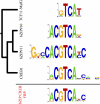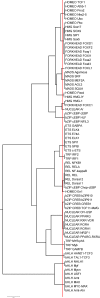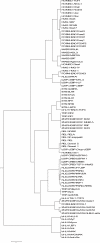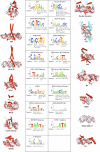DNA familial binding profiles made easy: comparison of various motif alignment and clustering strategies
- PMID: 17397256
- PMCID: PMC1848003
- DOI: 10.1371/journal.pcbi.0030061
DNA familial binding profiles made easy: comparison of various motif alignment and clustering strategies
Abstract
Transcription factor (TF) proteins recognize a small number of DNA sequences with high specificity and control the expression of neighbouring genes. The evolution of TF binding preference has been the subject of a number of recent studies, in which generalized binding profiles have been introduced and used to improve the prediction of new target sites. Generalized profiles are generated by aligning and merging the individual profiles of related TFs. However, the distance metrics and alignment algorithms used to compare the binding profiles have not yet been fully explored or optimized. As a result, binding profiles depend on TF structural information and sometimes may ignore important distinctions between subfamilies. Prediction of the identity or the structural class of a protein that binds to a given DNA pattern will enhance the analysis of microarray and ChIP-chip data where frequently multiple putative targets of usually unknown TFs are predicted. Various comparison metrics and alignment algorithms are evaluated (a total of 105 combinations). We find that local alignments are generally better than global alignments at detecting eukaryotic DNA motif similarities, especially when combined with the sum of squared distances or Pearson's correlation coefficient comparison metrics. In addition, multiple-alignment strategies for binding profiles and tree-building methods are tested for their efficiency in constructing generalized binding models. A new method for automatic determination of the optimal number of clusters is developed and applied in the construction of a new set of familial binding profiles which improves upon TF classification accuracy. A software tool, STAMP, is developed to host all tested methods and make them publicly available. This work provides a high quality reference set of familial binding profiles and the first comprehensive platform for analysis of DNA profiles. Detecting similarities between DNA motifs is a key step in the comparative study of transcriptional regulation, and the work presented here will form the basis for tool and method development for future transcriptional modeling studies.
Conflict of interest statement
Figures









References
-
- Stormo GD. DNA binding sites: Representation and discovery. Bioinformatics. 2000;16:16–23. - PubMed
-
- Rudolph MJ, Gergen JP. DNA-binding by Ig-fold proteins. Nat Struct Biol. 2001;8:384–386. - PubMed
-
- Pabo CO, Peisach E, Grant RA. Design and selection of novel Cys2His2 zinc finger proteins. Annu Rev Biochem. 2001;70:313–340. - PubMed
-
- Auron PE. DNA sequence-specific transcription factors. In: Lotze MT, Thomson AW, editors. Measuring immunity: Basic science and clinical practice. 1st edition. London: Elsevier; 2004. pp. 91–109.
Publication types
MeSH terms
Substances
Associated data
- Actions
- Actions
- Actions
- Actions
- Actions
- Actions
- Actions
- Actions
- Actions
- Actions
- Actions
- Actions
- Actions
Grants and funding
LinkOut - more resources
Full Text Sources
Research Materials
Miscellaneous

